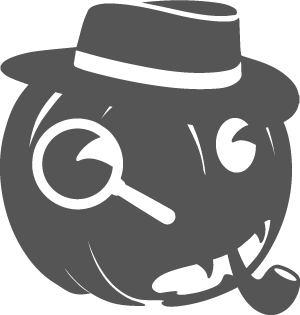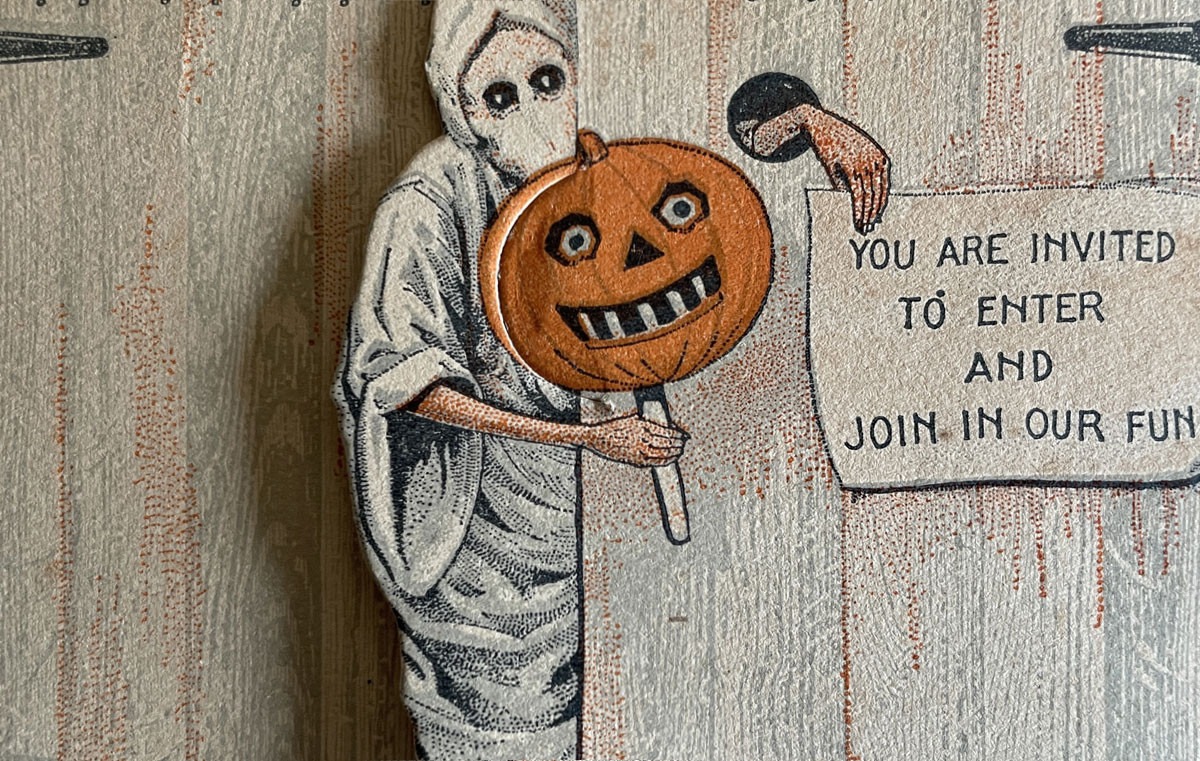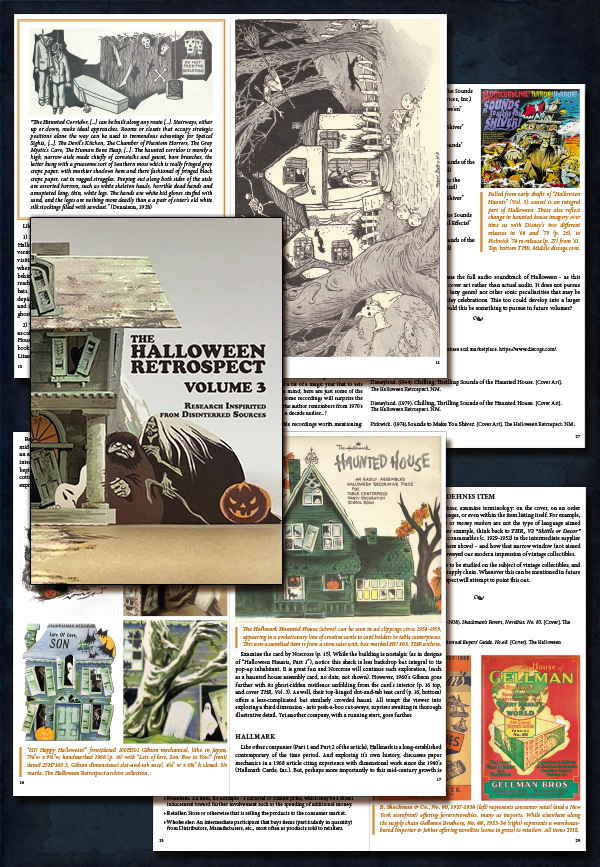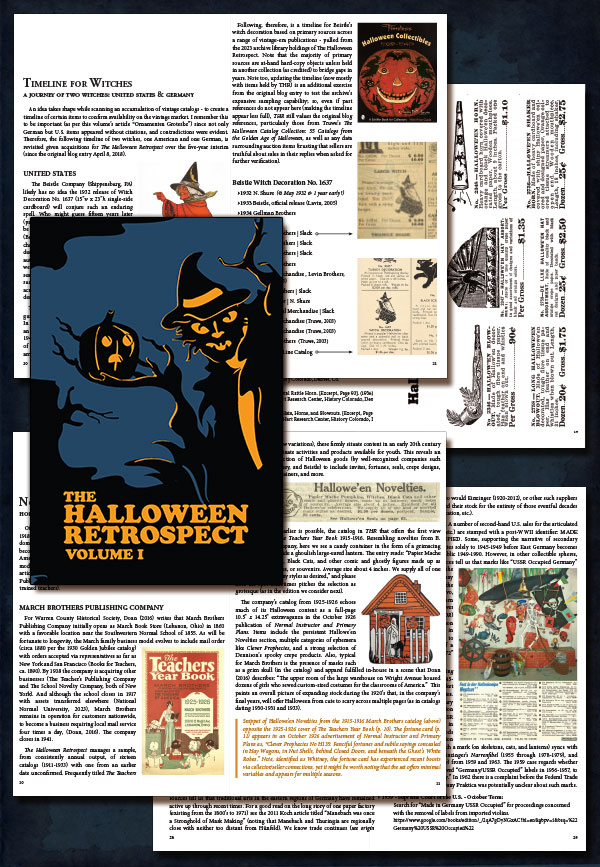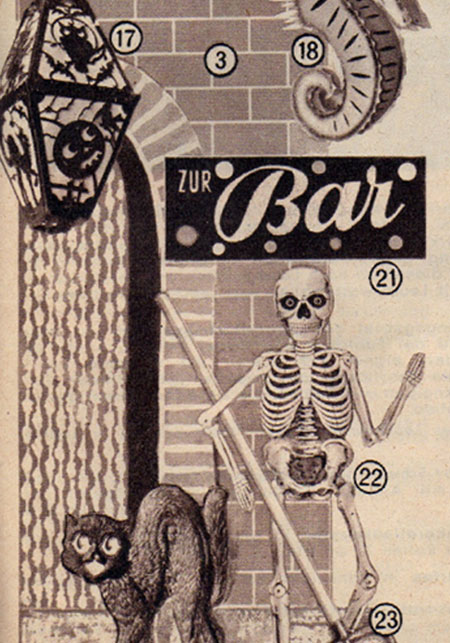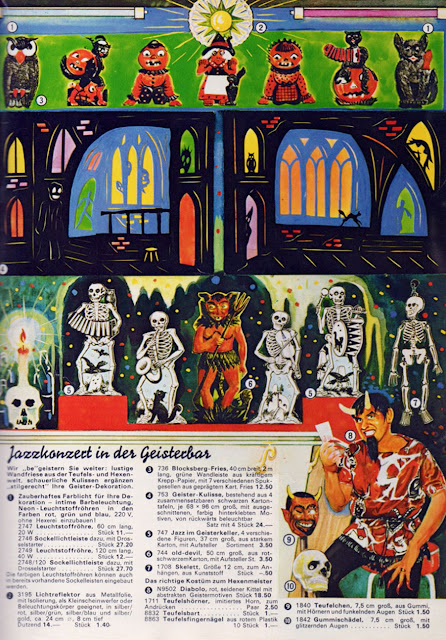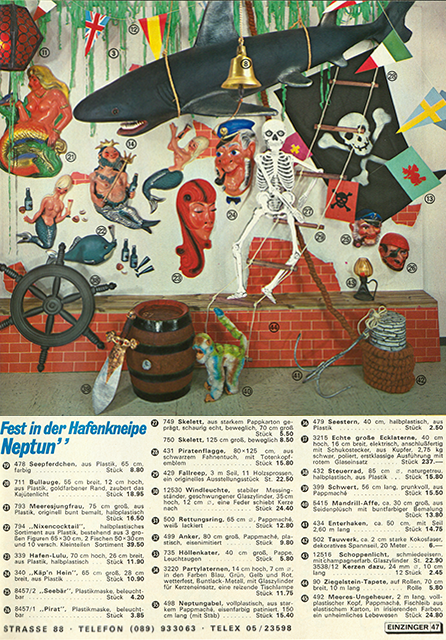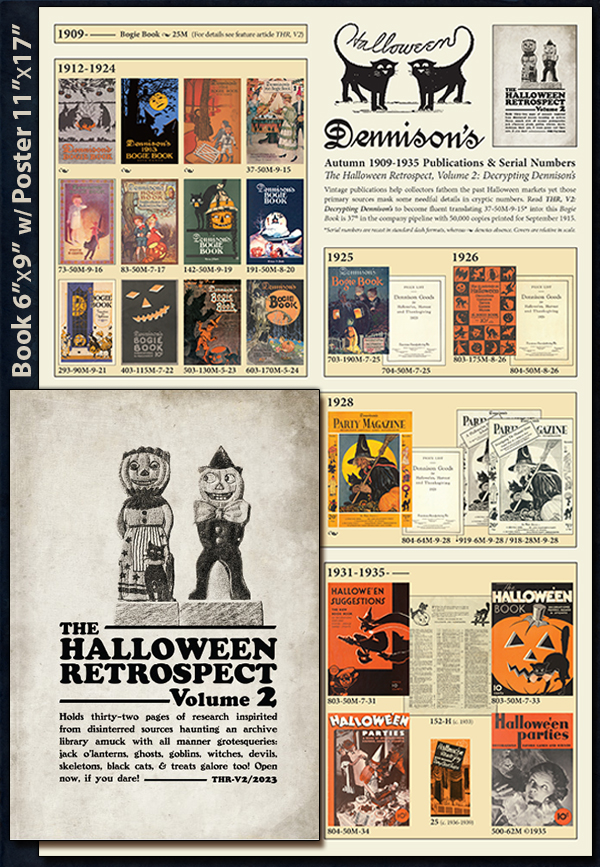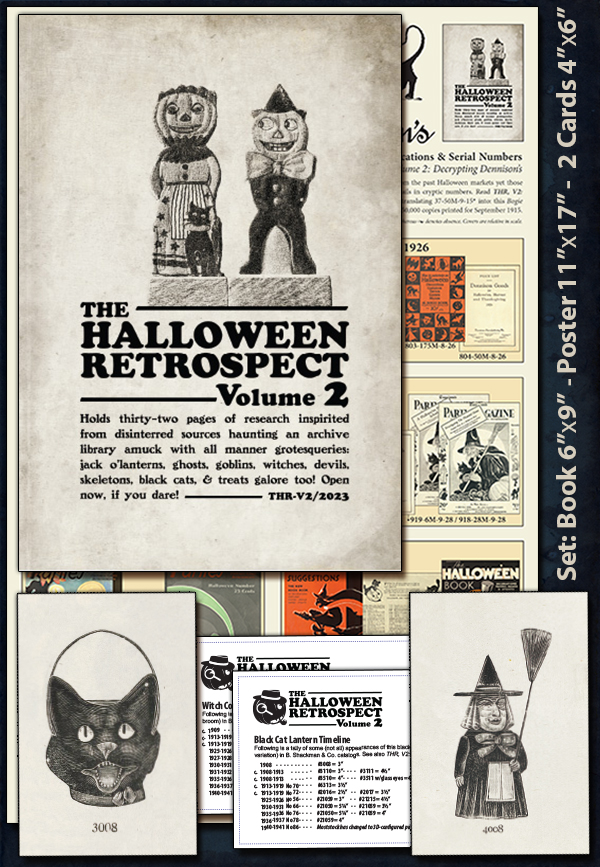Mysteries of Source & Credit
This entry was bound for a fitful start of overthink, yet the contents are completely topical to the recent edition of The Halloween Retrospect, Volume 2 and to my own experience as collector, archivist, librarian, and researcher. I believe these are important notes regarding vintage data, source, and credit, as these concepts relate to operational procedures (past, present, and future) for The Halloween Retrospect.
As I have stated since the beginning of any commentary on vintage Halloween collectibles (and as I do in the introduction of current volumes) – I am not a self-proclaimed expert . My goal has always been instead to let primary sources offer their own voice. Therefore, the results come not from to a single person, but instead owe much to the discoverability and accessibility of vintage references as made possible by the efforts of others, long before I write a single word. I suppose you could say, I later put the pieces together in my mind and in print, in turn offering my sources to the reader.
The Halloween Retrospect, Volume 1, Volume 2, and Volume 3 – page samples.
On this topic, following are some new items (from THR), and some oldies (from The Sane Halloween Observer) for your perusal:
1909 Bogie Book
Having recently published “Decrypting Dennison: Serial Number Guide Featuring Autumn Publications” (THR, V2), this item is only days old…
There has been much conjecture about The Dennison Bogie Book of 1909, sometimes denigrated by the very collectors desiring it. Yet, many statements surrounding this edition have been offered without sources. Most recently the item was portrayed as that which “Dennison didn’t have a clear idea of what they wanted to achieve” and that the result had “a lack of focus.” (Ledenbach, 2024) However, in a correspondence discussing the upcoming publication, the company shows great concern for the outcome. An excerpt from that internal 1909 letter by Dennison employee Preston Pond proudly describes the project as follows:
“In connection with our October advertising, emphasizing the Hallowe’en line, we are going to issue a small book. In it will be illustrated all the devices and designs for celebrating this crazy event. All Hallowe’en goods will be priced and it will stand as an announcement of our equipment to meet demands of the celebration. It is also going to carry with it suggestions for decorating and games. We have seen the layout. The cover is very effective, and I think the book as a whole will be very impressive.”
Next, there is the question of print run total regarding rarity, and again it appears we find more conjecture. One earlier proposal for that total stated that “the effort [book] yielded so little[,] that evidence shows Dennison destroyed almost all of the ~1,000 copies.” That is extremely interesting – and that Dennison felt it necessary to eradicate their own book, but there is no source. Later, the number is replaced with, “Dennison may have printed up to 25,000 copies, but that is uncertain.” This is also given no source . Presented in this manner, neither figure delivers data for future researchers. There is, however, a vintage source that helps explain the latter In the same internal letter by Pond:
“My thought had been that we should have an issue of 10 M, giving to each house 2 M. On second thought, it seems to me this is too small a quantity to cover demands made by advertising and our own Art Departments, and to do justice by the dealer. Do you agree with me that 2 M. is too small for each house? Would 5 M. for each house be out of place, or, in other words, an issue of 25 M.?”
You can now provide Pond’s letter as a source for the proposed print run figure of 25M. And, if you already own The Halloween Retrospect, Volume 2, you know this 1909 letter resides in the Dennison archives of Framingham History Center (and you may already know you can see this letter shared on IG @dennisonarchivist).
But, more to the point (of such figures as 25 M), THR, V2 readers discover a 1913 letter from the Dennison archives as key to publication serial numbers, particularly 1910’s-1930’s. These serial numbers contain amounts for print runs! In article “Decrypting Dennison: Serial Number Guide Featuring Autumn Publications” (THR, V2), Dennison fans (whether of vintage Halloween or general enthusiast) learn how to read this cryptic numbers (see below). They know that for the 1913 Bogie Book, one house (aka store, of which there were six in 1913), receive 1,000 each, or 6,000 – while the remaining distribution of 19,000 is broken down further (as sent to offices, dealers, home base, and more).
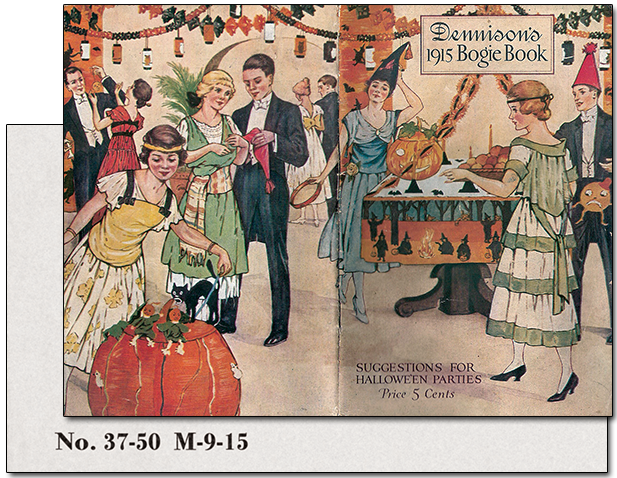
Dennison vintage Halloween titles, like the 1915 Bogie Book (above) contained serial numbers which are explained in vintage guidebook The Halloween Retrospect, Volume 2.

Shown here is the poster insert that comes with vintage Halloween guidebook (THR, V2). This poster lines up the 1910’s-1930’s autumn publications together with known serial numbers.
For more on how the Dennison archive came to be, see Framingham History Center To Unveil Dennison Manufacturing Company Exhibit (C. Frary, 11- 21-2014). There is the Dennison Manufacturing Company Archives, 1844-1990: A Finding Aid ” of 273 archival boxes, and another 425 boxes are housed at Harvard Business School as the Dennison Manufacturing Company records collection.
Sources
Green, J. L. (1913). Christmas Committee Letter No. 106. Dennison Manufacturing Company
Archives, 1844-1990 (14.08.05). Framingham History Center, Framingham, MA.
Ledenbach, M. B. (2024, January 18). Second copy of 1909 Dennison Bogie Book Discovered! Halloween Collector.com.
https://halloweencollector.com/blog/2024/1/16/second-copy-of-1909-dennison-bogie-book-discovered.
Please note – the reference had an initial version from which the quote of 1,000 copies is pulled.
Pond, Preston. (1909). Correspondence: The Dennison Bogie Book. Dennison Manufacturing
Company Archives, 1844-1990. Framingham History Center, Framingham, MA.
Dennison Electro
How else has a vintage primary source been helpful lately? For some time I have had, at-hand in the archives of The Halloween Retrospect, what I thought to be a printing block for one of Dennison’s vintage cards. However, the design of it was not quite right to the original card. I could not figure this out, and so held the item back for later research.
Recently, while sifting through IG feeds, I discover the exact nature of the item by accident! It is not for the production of the original ephemera, but instead an advertising tool for printers for those promoting Dennison products to the public. This so-called electro makes its vintage appearance in Dennison’s What Next? of 1928. You can see this item shared (with additional info) on THR’s IG account @halloweenretrospecs with a grateful nod to @dennisonarchivist for offering images of the vintage publication.
NOTE: please consider a donation or the purchase of a Membership to help support the Framingham History Center. I am sure most of us know the challenges all archives and libraries face to remain discoverable and accessible. If we, as collectors, can spend a bit of money on vintage objects, we can aid the institutions that further our knowledge. THR, though a hobbyist venture, has pledged to donate a portion of each sale from THR, V2 to Framingham History Center as a show of gratitude.
Under-informed Bozo
To close, since the early days of The Halloween Observer, I have been told I take things too seriously by questioning the content of survey books, and that to do so is arrogant. And yet, in offering more data than previously available to the general public, I receive contradictory barbs such as under-informed bozo. I wonder – did I set forth to share my exciting finds without consulting the gatekeepers (?) – a concept that reminds me of the masked figure guarding the Dennison invitation shown in this entry’s banner.
To review, many of the jabs aimed in this direction occur when pointing out bits from vintage print sources not adhering to secondary sources . For example, it was apparently worth noting in a peeved comment when The Sane Halloween Observer posts (circa 2015) shared German market catalogs of overseas diecut availability, including details on mark requirements of a post-WWII market. The print dates on those various catalogs spanned 1955 to the 1970’s (with none from the 1980’s until recently). And even though this additional information was unwelcome by some, no contrary data was ever presented to explain these catalogs (other than conjecture about past events).
To read more on the original catalogs, those articles are still located at The Sane Halloween Observer as a seven-post reading list: Ornamenten Groteske (2015-2020). Some of that information, not all, has since been transcribed to The Halloween Retrospect, Volume 1.
A skeletal history – the slides above show catalogs excerpts from 1955, 1965, 1975, and 1988 as a small sample of pages with German embossed diecuts. Yes, these are many of supposed rarity given earlier timelines, so please explain, with vintage sources (not stories) why secondary sources claim these were only available from the 1920’s to 1930’s.
Vintage Halloween Guidebook
To recap this (and recent blog entries like Dennison Halloween and Dennison Publications), THR’s research (about Dennison and their serial numbers) fills the majority page count of THR, V2 to assure the reader receives meaningful information — and the conclusive contents could not have occurred without participation from Framingham History Center archives. This author feels the THR, V2 result is packed with relative data that readers can use in their own collecting activities. And, again, the book includes a full-color fold-out poster (of Dennison titles pulled from THR archive library) as an all-in-one survey of Dennison’s Halloween-themed printing, particularly the 1910’s, 1920’s, 1930’s. For a visual review of this content in The Halloween Retrospect, Volume 2 see the sample gallery below:
You may wish to note, as well as the article outlined above, the second article in THR, V2 discusses B. Shackman & Co. catalogs (and pertinent data), with a third article researching the German imports (seen on the cover), ending with a fourth article gazing at midcentury midseason catalogs by Sears and their availability of cards by E. Rosen Company.
Here is a link to more website info about The Halloween Retrospect, Volume 2 (a new research-based guide on the vintage market of Halloween collectibles) and here is a direct link to The Halloween Retrospect book sales – purchase a copy via Etsy checkout.
Follow THR on Instagram @halloweenretrospecs
Follow THR on Facebook Halloween Retrospect
